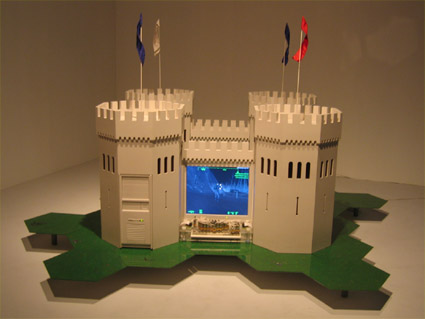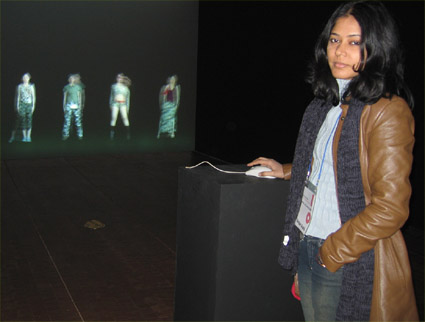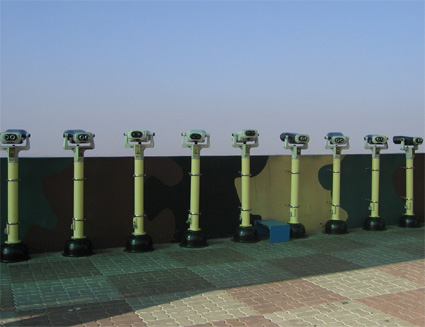Korea: gameplay
Josephine Starrs

Eddo Stern, Fort Paladin
photo Josephine Starrs
Eddo Stern, Fort Paladin
The 2004 Seoul International Media Art Biennale took its name, Homo Ludens, from a book published in 1938 by Dutch Historian John Huizinga, on the importance of play in human culture. A team of 5 international curators including Liz Hughes, Director of Experimenta Melbourne, put together this impressive exhibition of 45 works exploring the language and structure of games and play. There were 8 Australian pieces included and I was there with Bio-tek Kitchen, a computer game modification made in collaboration with Leon Cmielewski.
The speech by the Director of the Seoul Museum of Art delivered at the opening oozed with pre-dotcom crash rhetoric about the promise of new technologies, whereas the Korean artistic director, Yoon Jin Sup, spoke about the importance of artists bringing the human spirit to modern media and counteracting what he sees as the negative effects of computer game violence. As the line between computer games and military training and recruitment software is becoming increasingly blurred, it is not surprising that war emerged as a strong theme throughout the exhibition.
Eddo Stern, an Israeli artist based in the United States, built a small robot to play pre-programmed scenarios in the game America’s Army. Released by the American military as a recruiting tool, America’s Army was recently cited in the press as the most popular computer game in the history of the medium. In Stern’s installation, the game is housed in a miniature medieval fort reflecting the role-playing Dungeons and Dragons fantasy element that permeates gamer culture. The work’s title, Fort Paladin, references American military base-naming conventions.
Velvet Strike, a project by US artist Anne-Marie Schleiner, began as a response to the war on terrorism, with a competition inviting people to create and submit anti-war graffiti for Counter-Strike, a game allowing the user to play on a team as either terrorist or counter-terrorist. Counter Strike, a modification of the computer game Half-Life, was initially released as free software and quickly became so popular with online gamers that a commercial version was released in 2000, with enthusiastic gamers creating hundreds of new maps or mods for the game. The Velvet-Strike website (www.opensorcery.net/velvet-strike) presents a collection of images to be downloaded and used as graffiti on the walls, ceiling and floor of the game’s 3D environment. Schleiner is concerned about the current direction of computer game culture, and writes: “…although briefly showing signs of progress in the late nineteen-nineties, computer games have again been gendered as male fighting zones with so-called ‘realistic’ military sims gaining in popularity. This male militaristic culture coincides with a war climate in the US and other parts of the world where patriotism and military fetishism are on the rise” (catalogue essay, Games, Computerspiele von KunstlerInnen exhibition, Dortmund, Germany, October 2003).

Shilpa Gupta with her untitled installation at Homo Ludens
photo Josephine Starrs
Shilpa Gupta with her untitled installation at Homo Ludens
In the video installation by Mumbai artist Shilpa Gupta, viewers interact with video loops of a row of young women dressed in various camouflage fashion outfits. Clicking on each figure triggers different movements, such as marching, squatting, jumping and spoken phrases like “don’t interrupt”, “order order shop shop”, “shut up and eat”, “look straight” and “I belong to you.” As the viewer plays, it becomes clear that they are all the same woman—the artist herself. The work explores issues of control and fear, reflecting on the position of young middle class Indian women. Gupta says the concept for the piece was sparked by her observation that camouflage clothing had become hip since the war on terror began.
Back at my hotel in Seoul I watched the US Armed Forces TV station, where camouflage is definitely the preferred fashion of the blonde news presenters. The Korean War ended in 1953, but there are still 37,000 US military personnel stationed in South Korea, and Christmas messages were going out to them with images of troops enjoying time out with their families and giving presents of toy guns to their kids. There were also community announcements encouraging the military to say no to drugs and giving advice on how to cope with suicidal soldiers under one’s command. Apparently suicide is the second biggest killer of American troops, although we weren’t told what the first is.

Telescopes overlooking the Demilitarized Zone between North and South Korea
photo Josephine Starrs
Telescopes overlooking the Demilitarized Zone between North and South Korea
I travelled north from Seoul to visit the Demilitarised Zone (DMZ) between North and South Korea and followed the tunnel excavated by the North Koreans for a planned invasion of the South in the 1970s. Apparently this and other tunnels were discovered before the North Korean army had a chance to invade. At the border there is a row of binoculars set up on a platform, allowing visitors to gaze across the DMZ to the other side, where the North Koreans have set up a ‘freedom village’ so visitors can see how they live. I put my coin in the slot but my time ran out before I spotted any people in this part of the “axis of evil.” However I watched an eagle soaring over the DMZ, which has become a sanctuary for plants, birds and animals too small to trigger the landmines covering the area.
RealTime issue #65 Feb-March 2005 pg. 27






